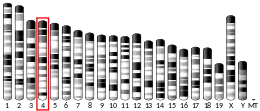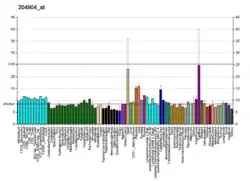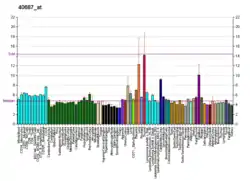GJA4
Gap junction alpha-4 protein, also known as Connexin-37 or Cx37, is a protein that in humans is encoded by the GJA4 gene.[5][6][7] This protein, like other Connexin proteins, forms connections between cells known as gap junctions. Connexin 37 can be found in many tissues including the ovary,[8] heart,[9] and kidney.[10]
References
- GRCh38: Ensembl release 89: ENSG00000187513 - Ensembl, May 2017
- GRCm38: Ensembl release 89: ENSMUSG00000050234 - Ensembl, May 2017
- "Human PubMed Reference:". National Center for Biotechnology Information, U.S. National Library of Medicine.
- "Mouse PubMed Reference:". National Center for Biotechnology Information, U.S. National Library of Medicine.
- Richard G, Smith LE, Bailey RA, Itin P, Hohl D, Epstein EH, DiGiovanna JJ, Compton JG, Bale SJ (December 1998). "Mutations in the human connexin gene GJB3 cause erythrokeratodermia variabilis". Nature Genetics. 20 (4): 366–9. doi:10.1038/3840. PMID 9843209. S2CID 841727.
- Reed KE, Westphale EM, Larson DM, Wang HZ, Veenstra RD, Beyer EC (March 1993). "Molecular cloning and functional expression of human connexin37, an endothelial cell gap junction protein". The Journal of Clinical Investigation. 91 (3): 997–1004. doi:10.1172/JCI116321. PMC 288052. PMID 7680674.
- "Entrez Gene: GJA4 gap junction protein, alpha 4, 37kDa".
- Winterhager E, Kidder GM (May 2015). Gap junction connexins in female reproductive organs: implications for women's reproductive health. Human Reproduction Update. 21. pp. 340–52. doi:10.1093/humupd/dmv007. PMID 25667189.
- Duffy HS, Fort AG, Spray DC (2006). "Cardiac connexins: genes to nexus". Cardiovascular Gap Junctions. Advances in Cardiology. 42. pp. 1–17. doi:10.1159/000092550. ISBN 978-3-8055-8077-9. PMID 16646581.
- Hanner F, Sorensen CM, Holstein-Rathlou NH, Peti-Peterdi J (May 2010). "Connexins and the kidney". American Journal of Physiology. Regulatory, Integrative and Comparative Physiology. 298 (5): R1143–55. doi:10.1152/ajpregu.00808.2009. PMC 2867516. PMID 20164205.
Further reading
- Andrew L Harris; Darren Locke (2009). Connexins, A Guide. New York: Springer. p. 574. ISBN 978-1-934115-46-6.
- Beyer EC, Paul DL, Goodenough DA (July 1990). "Connexin family of gap junction proteins". The Journal of Membrane Biology. 116 (3): 187–94. doi:10.1007/BF01868459. PMID 2167375. S2CID 43264684.
- Haefliger JA, Bruzzone R, Jenkins NA, Gilbert DJ, Copeland NG, Paul DL (January 1992). "Four novel members of the connexin family of gap junction proteins. Molecular cloning, expression, and chromosome mapping". The Journal of Biological Chemistry. 267 (3): 2057–64. doi:10.1016/S0021-9258(18)46052-8. PMID 1370487.
- Risek B, Guthrie S, Kumar N, Gilula NB (February 1990). "Modulation of gap junction transcript and protein expression during pregnancy in the rat". The Journal of Cell Biology. 110 (2): 269–82. doi:10.1083/jcb.110.2.269. PMC 2116004. PMID 1688855.
- Willecke K, Jungbluth S, Dahl E, Hennemann H, Heynkes R, Grzeschik KH (December 1990). "Six genes of the human connexin gene family coding for gap junctional proteins are assigned to four different human chromosomes". European Journal of Cell Biology. 53 (2): 275–80. PMID 1964417.
- Van Camp G, Coucke P, Speleman F, Van Roy N, Beyer EC, Oostra BA, Willems PJ (November 1995). "The gene for human gap junction protein connexin37 (GJA4) maps to chromosome 1p35.1, in the vicinity of D1S195". Genomics. 30 (2): 402–3. PMID 8586454.
- Krutovskikh V, Mironov N, Yamasaki H (August 1996). "Human connexin 37 is polymorphic but not mutated in tumours". Carcinogenesis. 17 (8): 1761–3. CiteSeerX 10.1.1.610.8446. doi:10.1093/carcin/17.8.1761. PMID 8761439.
- Simon AM, Goodenough DA, Li E, Paul DL (February 1997). "Female infertility in mice lacking connexin 37". Nature. 385 (6616): 525–9. Bibcode:1997Natur.385..525S. doi:10.1038/385525a0. PMID 9020357. S2CID 4363114.
- Krenacs T, Rosendaal M (April 1998). "Connexin43 gap junctions in normal, regenerating, and cultured mouse bone marrow and in human leukemias: their possible involvement in blood formation". The American Journal of Pathology. 152 (4): 993–1004. PMC 1858239. PMID 9546360.
- van Rijen HV, van Kempen MJ, Postma S, Jongsma HJ (April 1998). "Tumour necrosis factor alpha alters the expression of connexin43, connexin40, and connexin37 in human umbilical vein endothelial cells". Cytokine. 10 (4): 258–64. doi:10.1006/cyto.1997.0287. PMID 9617570.
- Boerma M, Forsberg L, Van Zeijl L, Morgenstern R, De Faire U, Lemne C, Erlinge D, Thulin T, Hong Y, Cotgreave IA (August 1999). "A genetic polymorphism in connexin 37 as a prognostic marker for atherosclerotic plaque development". Journal of Internal Medicine. 246 (2): 211–8. doi:10.1046/j.1365-2796.1999.00564.x. PMID 10447790.
- Saito T, Krutovskikh V, Marion MJ, Ishak KG, Bennett WP, Yamasaki H (April 2000). "Human hemangiosarcomas have a common polymorphism but no mutations in the connexin37 gene". International Journal of Cancer. 86 (1): 67–70. doi:10.1002/(SICI)1097-0215(20000401)86:1<67::AID-IJC10>3.0.CO;2-1. PMID 10728596.
- Suzuki Y, Taira H, Tsunoda T, Mizushima-Sugano J, Sese J, Hata H, Ota T, Isogai T, Tanaka T, Morishita S, Okubo K, Sakaki Y, Nakamura Y, Suyama A, Sugano S (May 2001). "Diverse transcriptional initiation revealed by fine, large-scale mapping of mRNA start sites". EMBO Reports. 2 (5): 388–93. doi:10.1093/embo-reports/kve085. PMC 1083880. PMID 11375929.
- Tsai MY, Lan KC, Huang KE, Huang FJ, Kung FT, Chang SY (December 2003). "Significance of mRNA levels of connexin37, connexin43, and connexin45 in luteinized granulosa cells of controlled hyperstimulated follicles". Fertility and Sterility. 80 (6): 1437–43. doi:10.1016/j.fertnstert.2003.05.015. PMID 14667880.
- Seul KH, Kang KY, Lee KS, Kim SH, Beyer EC (July 2004). "Adenoviral delivery of human connexin37 induces endothelial cell death through apoptosis". Biochemical and Biophysical Research Communications. 319 (4): 1144–51. doi:10.1016/j.bbrc.2004.05.097. PMID 15194487.
- Kameritsch P, Khandoga N, Nagel W, Hundhausen C, Lidington D, Pohl U (April 2005). "Nitric oxide specifically reduces the permeability of Cx37-containing gap junctions to small molecules". Journal of Cellular Physiology. 203 (1): 233–42. doi:10.1002/jcp.20218. PMID 15481066.
This article is issued from Wikipedia. The text is licensed under Creative Commons - Attribution - Sharealike. Additional terms may apply for the media files.





